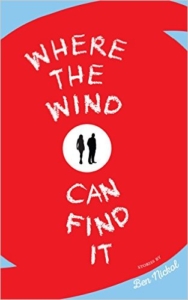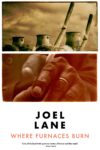 [Queen’s Ferry Press; 2015]
[Queen’s Ferry Press; 2015]
We lie to protect. And we lie to avoid. And we lie because, well, sometimes it’s just easier than the alternative. In the short-story collection Where the Wind Can Find It, Ben Nickol writes of dishonest characters with honest prose. Like “As If at Any Moment,” where a woman learns of her husband’s gambling addiction and its dangers for their family. Or “Above It All,” a story about sour ex-lovers who — accompanied by their new partners — run into each other for the first time in years at a youth basketball game in Seattle where their kids will play each other in the championship. Better yet: “Flamingo Motel,” which follows a recently fired investment banker who flies home to surprise his parents but ends up spying on his ex-girlfriend. Throughout this collection, Nickol successfully limns a space between the false and the true, in which the same conclusion — suffering and loneliness — follows from both facts and deceits.
Nickol’s focus on the consequences of manipulating the truth rather than simply the process of manipulation is good news for potential readers. We might distinguish between good and bad lies in an ethical sense, but the distinction also applies to entertainment. Stories that turn on the (un)artful reveal often underwhelm: the surprise you saw coming, or the surprise you didn’t see coming but reject on the unequivocal principle of despising all surprises (birthday parties, practical jokes, practical jokes at birthday parties, etc.). Nickol, however, goes beyond the familiar and feared tropes of the mendacious by creating characters that show us a complicated world rather than a clear moral agenda.
In “Knotted,” the second story in the book, the narrator, a washed-up golf pro named Leslie, offers: “these men, and I pity them, lead a life between lives. They’re one thing at happy hour and another at work, professing at each station that that’s who they are.” Leslie thinks this in reference to a group of lawyers at the golf course’s lounge, but the comment also applies to him and several other characters in the collection. Throughout the story, Leslie delivers his unreliable, unlikeable, or self-indulgent thinking, which includes little bits like the following: “They like me, these lawyers, because I am (or was?) the real deal, and being near me validates them.” Leslie’s a drinker, despite his insistence otherwise: “I’m not an alcoholic. This isn’t denial, either — I’m really not.” While Leslie reflects on his past, particularly the promise of his career when he played golf in college, he begins dating one of the lawyers, Jennifer, who takes Leslie to a party with her friends, where he then embarrasses himself.
After the party, Leslie, humbled by his physical and emotional inadequacy, whacks golf balls all alone on the course. As the shots cut off more and more in undesirable directions, he thinks: “It’s all false, and pretty soon I’m ready to cry. In a few years I’ll be thirty, and it’s suddenly so ridiculous that I’ve devoted my life not just to a game, but a game I’m not good at.” In the image of Leslie hitting the golf balls — and failing to strike them how he would like — as he finally admits his failure, Nickol’s story makes a solid stab at the Joycean epiphany. But Nickol uses this revelation, this moment of sincerity from a continuously misleading character, not to redeem, but to further sink. Leslie proceeds to order a bourbon from the guy driving a snack-cart. He makes several normative claims about his future. But it is clear based on his actions — bourbon, sucking at golf, standing all alone on the course — that nothing will improve. Leslie’s admission of what the reader already knows feels satisfying. But his choice to then ignore what he and the reader now understand is frustrating, and it suggests the future troubles Leslie will make for himself. This move — subverting the anticipated epiphany — testifies to the dark reality of the entire book, where an awareness of the truth fails to slow down the effects that lies have already set in motion.
Other stories in the collection, while also considering the effects of falsity for families and friends and lovers, use a sharp and precise style much like “Knotted.” In the story “Missing,” for instance, Nickol puts his variety of lyrical realism on display. As a search team looking for a missing child on the mountain of a ski resort, the setting of the story becomes a character of its own. The precise descriptions of place are in tension with the psychological distance the story maintains from its characters: a Hemingway-like move, sure, but one that feels original in how it navigates the image. While people remain uncertain and conflicted in the story, the environment stays steady, orientating, and honest:
Dusk arrived at four. The throngs jamming the chairlifts evaporated, revealing the corded lanes that all day had organized them. It was like the discovery of a skeleton. Below the village, down the road to town, the terraces of parking drained, revealing expanses of stained snow.
This is some of Nickol’s best prose: sentences pinned to the physical that lead the reader through an absence, as the landscape contains no subjects, only objects, all of which reify this sense of loss.
After dusk falls, the story introduces us to Claire, who is drinking at the resort’s bar. When Claire learns that a young girl disappeared off the ridge, she sets off to help the search. She approaches strangers throughout the night, some in the resort and others outside, telling them about the child. Eventually she joins a search team. Prospects of finding the missing girl are poor. But this realization obliquely reveals the sense of emptiness these characters feel for events outside of the narrative. The story could have ended with Claire leaving the resort — a compelling scene, as the bartender tells Claire that she leaves places too often — but it doesn’t. Instead, the story moves ahead in time to the moment when a lone skier comes across what he believes to be the body of the missing child. He denies it is her and continues skiing. Once the skier passes the body, the narrator shifts to the second person, addressing the lost child directly. Here, what is real can only be acknowledged by a voice outside of the characters, marking a complication in how the stories handle actuality: Nickol shows that our perspectives might shield us from the truth, but they still cannot change what is the case.
This idea is further developed in “At Your Side,” one of my favorites in the collection, and one of the more self-aware stories in the book. The story follows a priest struggling with writer’s block as he prepares a eulogy for a young man. The narrator tells the reader: “There was a joke I had with other clergy. On the first day, God created priests, pens, and coffee. A week later, He sat in the pew and waited.” The narrator’s crisis is not so much spiritual — “Prayer, after all, cannot be false. It merely expresses longing, without aspiring to truth” — but linguistic. The priest, as he watches the mortician prepare the body, finds the relationship between language and reality to be misleading. Before we can understand the language of the metaphysical, we should probably first trust our language to refer to objects in nature. The priest’s distrust of words to accurately describe or refer to the corpse precludes any understanding of a higher, spiritual language. In “Missing,” we saw a character deny death. Here, the priest doubts our ability to even talk about death. While the philosophic skepticism about naming and reference are commonplace, Nickol’s description of the corpse coupled with the priest’s speculations separate this story from others in the book, as his strengths meet to create a fresh dilemma for a character — the priest — that has been a frequent visitor to fictional worlds throughout the years.
This is an accurate statement of the collection as a whole. Where the Wind Can Find It is an impressive first book of stories that nails a particular aesthetic. When thinking of first books, a writer might attempt to break open a genre, which often reads as less original than promised and much messier than it should. Ben Nickol succeeds in executing his project, one that is familiar but undoubtedly his, in a collection of stories that feel closely related in their thematic content but vastly different in how they approach the material. Nickol considers his subject — lying, falsity, etc. — from opposing angles: some right at the center, others in the periphery, and still others outside the frame entirely. The ten stories feel in dialogue with each other, like a group therapy session for those disturbed by the constraints of subjectivity. And at the therapy session, no two people have the exact same experience, yet everyone can nod their heads and sympathize. Nickol gives us families, loners, priests, bankers, all to suggest a universal dilemma. And rather than offer resolutions to the problem, the stories continue raising and expanding the issue. These stories hurt in a good way: real, gritty fiction from a promising writer.
This post may contain affiliate links.







